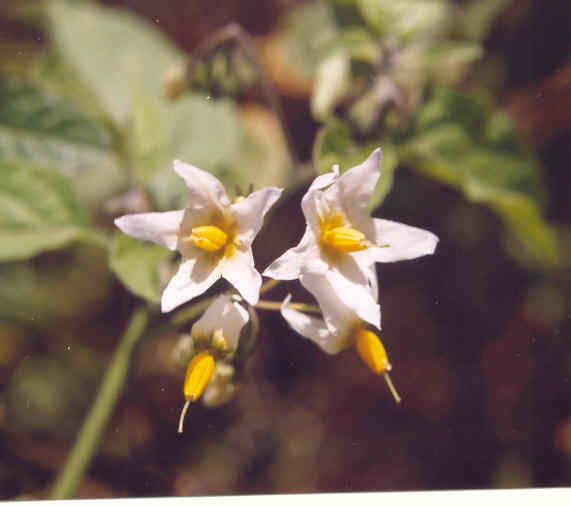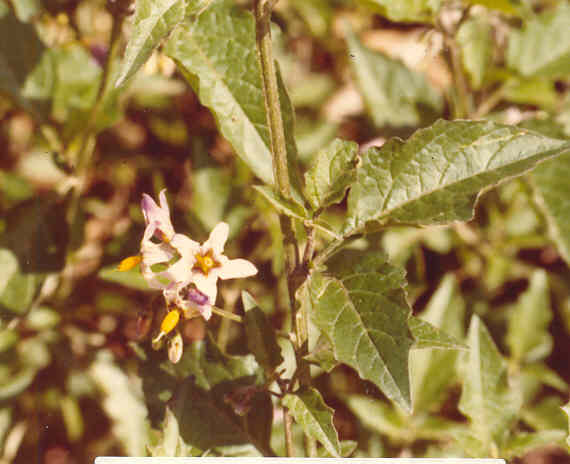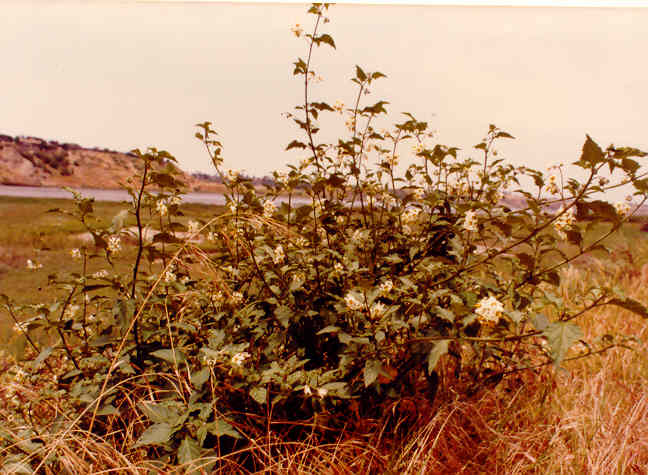
Solanum douglasii Dunal
 |
Solanum douglasii Dunal
Solanaceae (Nightshade Family)NativeDouglas' Nightshade |
May Photo
Plant Characteristics:
Perennial, +/- woody, 1-2 m. tall; herbage puberulent to subglabrous, the
stem-angles rough-pubescent; lf. blades ovate, 2-10 cm. long, sinuate-dentate,
subacuminate; petioles 1-2.5 cm. long; infl. generally umbel- like peduncles 1-3
cm. long; pedicels 0.5-1.2 cm. long; calyx 2-3 mm. long at anthesis, with
lance-oblong lobes; corolla deeply 5-cleft, whitish with greenish basal spots,
1-2 cm. broad, the lobes lance-oblong, 6-11 mm. long; anthers ca. 3-4 mm. long;
berry black, 6-9 mm. in diam.
Habitat:
Partly shaded slopes, in canyons, etc. below 3500 ft.; Coastal Sage
Scrub, Chaparral, Coastal Strand, etc.; cismontane mainland, San Clemente and
Santa Catalina Ids. and Channel Ids.; to cent. Calif., L. Calif., Mex.
Most of the year.
Name:
Solanum is "quieting" in Latin and was given because of
the narcotic properties of some species. The
species name is in honor of David Douglas, 1798-1834, Scottish botanist.
He made several scientific journeys to America spending some four years
(1829-1832), mostly in California, collecting for the Horticultural Society of
London. Douglas provided the
material from which some 300 species of California plants were to be described.
(Jaeger 308).
General:
Common in the study area. Photographed
along Back Bay Dr. between the Newporter Inn and San Joaquin Hills Dr., also
westerly of the Delhi Ditch. (my
comments). The Indians are said to have used the juice
of the berries for tattooing and to cure inflamed eyes.
(Dale 194).
The nightshade has been suspected in livestock poisoning.
(Robbins et al. 389).
The fruit are not poisonous and are called wild tomato. (lecture by Charlotte Clarke, author of Edible and Useful
Plants of California, April 1987.
The Cahuilla Indians, inhabitants of the Colorado Desert, the San Jacinto
and San Bernardino Mountains, used the juice of S. douglasii medicinally
for sore or infected eyes. The
juice was squeezed directly into the eye or first diluted with water.
It was considered a cure for pink eye and a remedy for eye strain.
It was also said that as an eye wash the nightshade improved the vision
of older people. Solanine, a
glyco-alkaloid, found throughout the plant is extremely toxic.
(Bean and Saubel 140).
While Clarke reports that the fruit of S. douglasii is not
poisonous, Lampe, K.F. and McCann,
M.A. 1985, report in the AMA Handbook of Poisonous and Injurious Plants
that the green fruit of S. nigrum, a species found in Orange County, is
extremely toxic, containing glyco-alkaloids.
All kinds of animals can be poisoned and have died after ingesting unripe
berries. Children have been
poisoned and have died after ingesting the unripe berries.
The ripe berries cause reduced symptoms of mild abdominal pains, vomiting
and diarrhea. Cooper,
M.R. and Johnson, A.W. 1984, in Poisonous Plants in Britain and Their
Effects on Animals and Man report that the common potato, S. tuberosum,
cultivated for its edible tubers is sometimes toxic.
The entire plant contains toxic glyco-alkaloids but usually in harmless
quantities in the edible tubers. However,
in the presence of light, the tubers photosynthesize and increase the amount of
toxins. The skin, eyes, and sprouts
of the tubers can develop toxic amounts of glyco-alkaloids.
Even the flesh of the tuber can develop toxic quantities of the
glyco-alkaloids. Cattle, sheep and
swine as well as humans were poisoned and died after ingesting parts of the
potato plant. The berries contain
10-20 times more glyco-alkaloids than the tubers.
Care should be taken to store potatoes in light-proof paper bags.
Potato peelings and sprouts destined for the compost heap should be
buried and kept from dogs or other animals.
Ingesting a potato, S. tuberosum, with green flesh, skin or tubers
causes sickness and, in some cases, human fatalities.
Symptoms of ingestion include those common to gastrointestinal problems
and nervous disorders. Clinical
signs include headache, vomiting, diarrhea and abdominal pain.
Neurological symptoms include apathy, restlessness, drowsiness, stupor,
confusion, hallucinations, dizziness, trembling, and visual impairment.
Certain birth defects are believed to result from ingesting potatoes with
potato blight (Phytophthora infestans).
However, no definitive proof has been found yet. (McMillan, M., Thompson,
J.C. 1979. "An Outbreak of Suspected Solanine Poisoning in Schoolboys:
Examination of Criteria of Solanine Poisoning."
Q.J Med., 48: 227-243).
The berries of S nodiflorum are poisonous, but boiling destroys
the toxic properties in the ripe, black, berries, often they are made into pies. Although the old leaves are poisonous, it is said that young
leaves and stems can be boiled as a pot herb.
Indians used a decoction as an eye wash. (Sweet 54).
Over 1000 species, of all continents, but especially trop. America.
(Munz, Flora So. Calif. 838),
Text Ref:
Hickman, Ed. 1076; Munz, Calif. Flora 597; Munz, Flora So.
Calif. 839; Roberts 40.
Photo Ref:
Feb-Mar 83 # 3,6; June 5 83 # 8; July 2 83 # 10; July 2 83 # 10; Jan 1 84
# 2; Jan 2 84 # 21; May 06 #10A.
Identity: by R. De Ruff, confirmed by F. Roberts.
First Found: February 1983.
Computer Ref: Plant Data 286.
Have plant specimen.
Last edit 6/3/06.
 |
 |
 |
March Photo June Photo July Photo